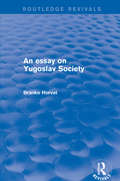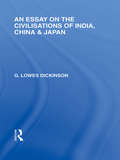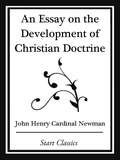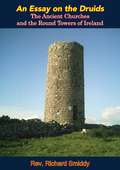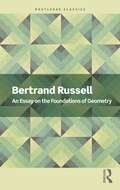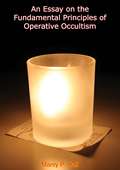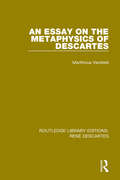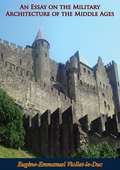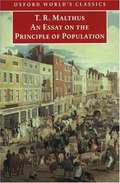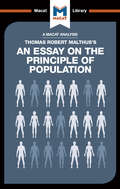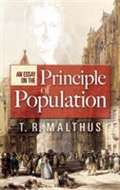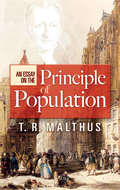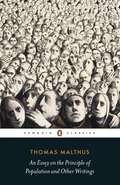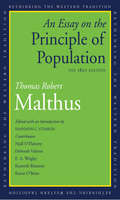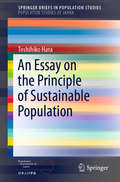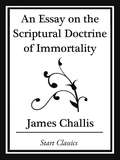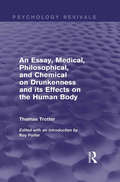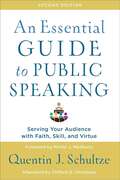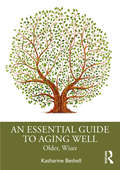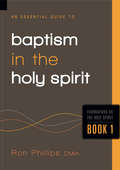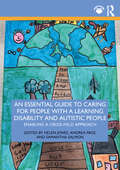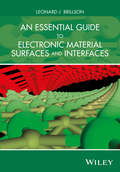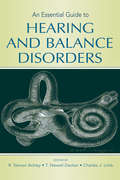- Table View
- List View
An Essay on Yugoslav Society
by Branko HorvatThis title was first published in 1967. In the foreword the author states that the present Essay was not written in haste, and probably cannot be read through in haste either. It is the result of my thinking about our society for the last sixteen years. The section "The Transition Period" was written and published as long ago as 1951 ; the last section, on the theory of the party, was written only after the Brioni Plenum of the Central Committee of the Communist Party of Yugoslavia, when study of these problems had become socially relevant, in the sense of the quotation of Marx that has been adopted as the epigraph of this book. Part of the text has been published in Ekonomist, Pregled, Gledüta and Na&e teme. Part I and Chapters 11 and 14 are taken from my book Towards a Theory of Planned Economy.
An Essay on the Civilisations of India, China and Japan (Routledge Library Editions: Japan)
by G Lowes DickinsonThis volume presents an account of the author’s travels during 1912-13 making particular note of the characteristics of Indian, Chinese and Japanese societies and the effect upon them of contact with the West. Although inevitably dated in some of its views, the volume nonetheless provides an excellent starting point for comparisons between East and West and the strengths and weaknesses of the individual cultures, be it in politics, literature or the arts.
An Essay on the Development Christian Doctrine (Start Classics)
by John Henry NewmanStill considered essential reading for serious thinkers on religion more than a century and a half after it was written, this seminal work of modern theology, first published in 1845, presents a history of Catholic doctrine from the days of the Apostles to the time of its writing, and follows with specific examples of how the doctrine has not only survived corruption but grown stronger through defending itself against it, and is, therefore, the true religion. This classic of Christian apologetics, considered a foundational work of 19th-century intellectualism on par with Darwin's Origin of Species, is must reading not only for the faithful but also for anyone who wishes to be well educated in the fundamentals of modern thought.
An Essay on the Druids,: The Ancient Churches and the Round Towers of Ireland
by Rev Richard Smiddy“Irish round towers (Irish: Cloigtheach (singular), Cloigthithe (plural); literally 'bell house') are early mediaeval stone towers of a type found mainly in Ireland, with two in Scotland and one on the Isle of Man. As their name Cloigtheach indicates, they were originally bell towers, though they may have been later used for additional purposes.A tower of this kind is generally found in the vicinity of a church or monastery, with the door of the tower facing the west doorway of the church. Knowledge of this fact has made it possible, where towers still exist, to determine without excavation the approximate sites of lost churches that once stood nearby.”-Wiki“WHEN the first Christian Missionary landed in Ireland he found the Druids and their religion strongly established there. The Druids were the priests of the ancient Celts. The word Druid is formed from the Irish name, Draoi (pronounced Dhree), which is believed to be a compound of the words dair, “oak,” and ai, “learned or wise,” that is, the learned or wise man of the oak. The oak was held in great veneration by the Druids. Under its branches, on the mountain tops and in the deep valleys, were performed the rites and mysteries of their religion; and it was in the woods and wilds they and their people sojourned while leading a roving life and subsisting on their flocks, during the early periods of their history.It appears that the Celts were a branch or colony, sprung from ancient Scythia. A wandering hardy people were the Scythians, who, disdaining to live in cities or towns, moved about from one place to another with their families and their flocks. In the course of ages they spread over a large portion of Asia, and even occupied many countries of Europe.”-Foreword
An Essay on the Foundations of Geometry (Routledge Classics)
by Bertrand RussellAn Essay on the Foundations of Geometry was first published in 1897 when Bertrand Russell was 25 years old. It marks his first major foray into analytic philosophy, a movement in which Russell is one of the founding members and figurehead. It provides a brilliant insight into Russell's early philosophical thought and an engaging and authoritative introduction to the philosophical and logical foundations of geometry - a version of which was fundamental to Einstein's theory of relativity. Russell explores and introduces the concepts of geometry and their philosophical implications, including a historical overview of geometrical theory, making it an invaluable resource not only for students of philosophy but anyone interested in the origins of the thought of one of the twentieth century's most important and widely-read philosophers. This Routledge Classics edition includes a new Foreword by Michael Potter.
An Essay on the Fundamental Principles of Operative Occultism
by Manly P. HallFirst published in 1929, this is one of Canadian-born mystical writer Manly P. Hall’s essays on the art of self-realization, as expressed through the wisdom of the ages.An Essay on the Fundamental Principles of Operative Occultism provides an early description of the seven spinal chakras and the science of regeneration.Beautifully illustrated with three oil paintings by Mihran K. Serailian.
An Essay on the History of Civil Society
by Fania Oz-Salzberger Adam FergusonAdam Ferguson's Essay on the History of Civil Society (first published in 1767) is a classic of the Scottish--and European--Enlightenment. Drawing on such diverse sources as classical authors and contemporary travel literature, Ferguson combines a subtle analysis of modern commercial society with a critique of its abandonment of civic and communal virtues. Central themes in Ferguson's theory of citizenship are conflict, play, political participation and military valor. The Essay is a bold and novel attempt to reclaim the tradition of active citizenship in the modern state.
An Essay on the Metaphysics of Descartes (Routledge Library Editions: Rene Descartes #4)
by Marthinus VersfeldOriginally published in 1940, this book provides a thorough discussion of René Descartes philosophy of metaphysics, examining the three major points of the mind and body, freedom of the will and religion and science. Specific chapters are devoted to the Cartesian theory and the Meditations, in particular the Sixth.
An Essay on the Military Architecture of the Middle Ages
by Eugène-Emmanuel Viollet-le-DucOriginally published in 1860, this book of military architecture features some truly spectacular examples of Roman and Medieval fortifications including castles, bastions, and camps. This remarkable work is a literal treasure trove of hard-to-find information on a litany of structures and defenses. An essay on military architecture and the various modes of warfare is presented along with details of each conquest. Representative of the best, most heavily fortified embattlements that were constructed from the days of Caesar through the Sixteenth century, this work includes engines of war, towers, cats, walls and wooden ramparts, drawbridges, moats, keeps, and curtain-walls of these castle forts and encampments. It is illustrated with eye views of medieval engagements, numerous sectional drawings as well as plans, and has complete descriptions of these classic wood, stone, and mortar structures revealing their secrets.-Print ed.
An Essay on the Principle of Population
by Thomas Robert Malthus Geoffrey GilbertMalthus's Essay looks at the perennial tendency of humans to outstrip their resources: reproduction always exceeds food production. Today Malthus remains a byword for concern about man's demographic and ecological prospects.
An Essay on the Principle of Population
by Nick BrotenThomas Robert Malthus’ 1798 Essay on the Principle of Population helped change the direction of economics, politics, and the natural sciences with its reasoning and problem solving. The central topic of the essay was the idea, extremely prevalent in the 18th and 19th centuries, that human society was in some way perfectible. According to many thinkers of the time, mankind was on a course of steady improvement with advances set to continuously improve society and life for all. Malthus was a skeptic on this point, and, in a clear example of the skill of reasoning, set about constructing and marshalling a strong argument for a less optimistic view. Central to his argument were the laws of population growth and their relationship to growth in agricultural production; in his view the former would always outstrip the latter. This provided a strong argument that society was limited by finite resources – a closely reasoned argument that continues to influence economists, politicians and scientists today, as well as environmental movements. While Malthus’ proposed solutions have been less influential, they remain an excellent example of problem solving, offering a range of answers to the problem of population growth and finite resources.
An Essay on the Principle of Population
by T. R. MalthusThe first major study of population size and its tremendous importance to the character and quality of society, this polemic examines the tendency of human numbers to outstrip their resources. Pivotal in establishing the field of demography, it remains crucial to understanding modern problems with food production and distribution. Anglican parson Thomas Robert Malthus wrote his famous essay in 1798 in response to speculations on social perfectibility aroused by the French Revolution. Because human powers of procreation so greatly exceed the production of food, Malthus explained, population will always exceed available resources, and many will inevitably live at the ragged edge of subsistence. His simple yet powerful argument -- demonstrating that scarcity and inequality arise even in a society purged of all unjust laws and institutions -- was highly controversial in its day. Many of Malthus' contemporaries despised him for dashing their hopes of social progress, and the grim logic of his "population principle" led Thomas Carlyle to dub economics "the dismal science. " Today, Malthus' name is practically synonymous with active concern about demographic and ecological prospects, and his classic remains ever relevant to issues of social policy, theology, evolution, and the environment.
An Essay on the Principle of Population
by T. R. MalthusThe first major study of population size and its tremendous importance to the character and quality of society, this polemic examines the tendency of human numbers to outstrip their resources. Pivotal in establishing the field of demography, it remains crucial to understanding modern problems with food production and distribution.Anglican parson Thomas Robert Malthus wrote his famous essay in 1798 in response to speculations on social perfectibility aroused by the French Revolution. Because human powers of procreation so greatly exceed the production of food, Malthus explained, population will always exceed available resources, and many will inevitably live at the ragged edge of subsistence. His simple yet powerful argument — demonstrating that scarcity and inequality arise even in a society purged of all unjust laws and institutions — was highly controversial in its day. Many of Malthus' contemporaries despised him for dashing their hopes of social progress, and the grim logic of his "population principle" led Thomas Carlyle to dub economics "the dismal science." Today, Malthus' name is practically synonymous with active concern about demographic and ecological prospects, and his classic remains ever relevant to issues of social policy, theology, evolution, and the environment.
An Essay on the Principle of Population and Other Writings
by Thomas MalthusMalthus' life's work on human population and its dependency on food production and the environment was highly controversial on publication in 1798. He predicted what is known as the Malthusian catastrophe, in which humans would disregard the limits of natural resources and the world would be plagued by famine and disease. He significantly influenced the thinking of Darwin and Alfred Russel Wallace and his theories continue to raise important questions today in the fields of social theory, economics and the environment.With an introduction by Robert Mayhew.
An Essay on the Principle of Population: The 1803 Edition
by Thomas Robert Malthus Shannon C. StimsonMalthus’s Essay on the Principle of Population remains one of the most influential works of political economy ever written. Most widely circulated in its initial 1798 version, this is the first publication of his benchmark 1803 edition since 1989. Introduced by editor Shannon C. Stimson, this edition includes essays on the historical and political theoretical underpinnings of Malthus’s work by Niall O’Flaherty, Malthus’s influence on concepts of nature by Deborah Valenze, implications of his population model for political economy by Sir Anthony Wrigley, an assessment of Malthus’s theory in light of modern economic ideas by Kenneth Binmore, and a discussion of the Essay’s literary and cultural influence by Karen O’Brien. The result is an enlarged view of the political, social, and cultural impact of this profoundly influential work.
An Essay on the Principle of Sustainable Population (SpringerBriefs in Population Studies)
by Toshihiko HaraThis book focuses on the future of the global population and proposes revising Malthus’ Law. The United Nations estimates that the global population will top 11 billion by 2100, at which point its growth will be near an end: it will find a new equilibrium in a long demographic transition from high birth and death rates to low ones. However, the author reviews the fertility developments reported in the World Population Prospects 2017, which are near or below the replacement level in most regions, with the important exception of Sub-Saharan Africa, and warns of a possible scenario of the extinction of human society. Returning to Malthus, his Essay on the Principle of Population is critically reconsidered. Simple simulations show that exponential growth and decay are unsustainable beyond the narrow ranges of the net reproduction rate. In addition, the length of reproduction periods, which depends on women’s lifespans, plays a pivotal role. The limits of growth are given in any case, to the extent that time and space will permit.From this perspective, teleological conditions such as instinct, passion, or even natural reproductive tendencies are irrelevant and unnecessary. When the population deviates too far from the replacement level, either its shrinking or massive growth will overshoot the limits of its existence. This principle of sustainable population indicates that the demographic transition must follow a logistic curve. Using a system dynamics approach, the author constructs a simulation model based on four major loops: fertility, reproduction timing, social capital accumulation, and lifespan. Using only endogenous variables, this model successfully reproduces the historical process of the demographic transition in Japan. Thereby, it shows that the timing and periods of reproduction, maximum fertility, and maximum lifespan hold the key to sustainability. Based on these findings, the author subsequently discusses recovering replacement fertility, extending lifespans, and the demographic future of the human race.
An Essay on the Scriptural Doctrine of Immortality (Start Classics)
by James ChallisBy immortality is ordinarily understood the doctrine that the human soul will survive death, continuing in the possession of an endless conscious existence. Together with the question of the existence of God, it forms the most momentous issue with which philosophy has to deal. It belongs primarily to rational or metaphysical psychology and the philosophy of religion, though it comes also into contact with other branches of philosophy and some of the natural sciences.
An Essay, Medical, Philosophical, and Chemical on Drunkenness and its Effects on the Human Body (Psychology Revivals)
by Thomas TrotterIt was during the course of the eighteenth and nineteenth centuries that the problem of chronic alcohol dependence in modern society and its consequent medical effects emerged. The topic of drunkenness figures prominently in the thinking and writing of social reformers, politicians, theorists, medical practitioners, and psychiatrists. Eventually, by the mid-nineteenth century, ‘alcoholism’ was named as the disease of habitual drunkenness. Possibly the most important book to predict this was Trotter’s Essay, written in 1804. Through case studies based on wide experience, he detailed the manifestations of alcoholism, ventured therapeutic recommendations, and squarely termed drunkenness a disease – indeed, a mental disease. Originally published in 1988 as part of the Tavistock Classics in the History of Psychiatry series, Roy Porter’s Introduction to this facsimile reprint locates Trotter’s work within the wider history of the evolution of the idea of alcoholism. It also examines the Essay in the context of Trotter’s own life and mind – a mind preoccupied with what he saw as the degenerative tendencies of modern civilization and with the wider issues of drug dependence.
An Essential Guide To Public Speaking: Serving Your Audience With Faith, Skill, And Virtue
by Quentin J. SchultzeCommunication expert and popular speaker Quentin Schultze offers a practical, accessible, and inspiring guide to public speaking, showing readers how to serve their audiences with faith, skill, and virtue. This thoroughly rewritten and expanded four-color edition has been tested and revised with input from Christian undergraduates and contains new chapters on timely topics, such as speaking for video, conducting group presentations, and engaging society civilly. A complete public speaking textbook for Christian universities, it includes helpful sidebars, tips, and appendixes. Additional resources for students and professors are available through Textbook eSources.
An Essential Guide to Aging Well: Older, Wiser
by Katharine BethellThis book is a refreshingly honest self-help guide to aging well. It encourages readers to dispel gloom or overcome denial around the subject of aging and offers advice in a realistic, non-prescriptive format. Practical yet personable, chapters move through pertinent topics such as making the decision to retire and successfully navigating that transition; designing daily routines (your practice) and engaging in activities (your projects); connecting with others as relationships shift and evolve; and managing moods and emotional issues. The guide also supports readers coping with illness or injury, experiencing loss and grief, and those searching for meaning as they grow older. Written in a conversational style, An Essential Guide to Aging Well motivates its readers to be curious about this time of life, and to design the best possible version of it for themselves.
An Essential Guide to Baptism in the Holy Spirit (Foundations on the Holy Spirit #1)
by Ron PhillipsThis book is part of the Foundation Series by Pastor Ron Phillips. The series will contain books describing the basic foundational truths for the Spirit-filled believer. An Essential Guide to Baptism in the Holy Spirit describes the author&’s own experience of being baptized by the Holy Spirit. It will demonstrate how the power of the Holy Spirit in our lives today can help us to preach the good news, drive out devils, heal the sick, and see God&’s kingdom on the earth grow.
An Essential Guide to Caring for People With a Learning Disability and Autistic People: Enabling a Cross-Field Approach.?
by Andrea Page Helen Jones Samantha SalmonThis essential text presents the core information that all nursing students and apprentices along with other key health and social care professions, regardless of field, need to know about caring for people with a learning disability and autism. It outlines some of the key challenges faced by people with a learning disability and autism, and ways in which good care can improve their quality of life. People with a learning disability and autism are more likely to need support with aspects of everyday life, be marginalised within society, including within health and social care, and die younger than the rest of the population. They are also more likely to have additional communication needs, sensory processing difficulties and require significant support to access healthcare as well as other opportunities across the course of their lives.This innovative text highlights the core knowledge that all health and social care professionals need and emphasises the benefits of learning across different fields of practice. It presents information about common conditions, key skills, and where a standard approach may need to be changed when caring for a person with a learning disability and autistic people. It demystifies key issues and commonly misunderstood concepts and topics including distressed behaviours, consent and reasonable adjustments. The book also focuses on addressing health inequalities, improving communication, understanding mental capacity and presents case studies throughout to illustrate how care can and should be delivered.Written for all who aspire to understand the needs of these individuals and to deliver care as effectively as possible, this collaborative text brings together the voices of services users and their families and carers, with those of nurses, other health professionals, lecturers, and nursing students and apprentices.
An Essential Guide to Electronic Material Surfaces and Interfaces
by Leonard J. BrillsonAn Essential Guide to Electronic Material Surfaces and Interfaces is a streamlined yet comprehensive introduction that covers the basic physical properties of electronic materials, the experimental techniques used to measure them, and the theoretical methods used to understand, predict, and design them. Starting with the fundamental electronic properties of semiconductors and electrical measurements of semiconductor interfaces, this text introduces students to the importance of characterizing and controlling macroscopic electrical properties by atomic-scale techniques. The chapters that follow present the full range of surface and interface techniques now being used to characterize electronic, optical, chemical, and structural properties of electronic materials, including semiconductors, insulators, nanostructures, and organics. The essential physics and chemistry underlying each technique is described in sufficient depth for students to master the fundamental principles, with numerous examples to illustrate the strengths and limitations for specific applications. As well as references to the most authoritative sources for broader discussions, the text includes internet links to additional examples, mathematical derivations, tables, and literature references for the advanced student, as well as professionals in these fields. This textbook fills a gap in the existing literature for an entry-level course that provides the physical properties, experimental techniques, and theoretical methods essential for students and professionals to understand and participate in solid-state electronics, physics, and materials science research. An Essential Guide to Electronic Material Surfaces and Interfaces is an introductory-to-intermediate level textbook suitable for students of physics, electrical engineering, materials science, and other disciplines. It is essential reading for any student or professional engaged in surface and interface research, semiconductor processing, or electronic device design.
An Essential Guide to Hearing and Balance Disorders
by R. Steven Ackley T. Newell Decker Charles J. LimbAn Essential Guide to Hearing and Balance Disorders consolidates the most significant clinical aspects of hearing and balance disorders, ranging from cause and diagnosis to treatment and cure. Experts in various subspecialties of this extensive topic introduce readers to the most sophisticated and state of the art methods of diagnosis and treatment. Each chapter expands on a specific topic area along the continuum of how medical personnel diagnose hearing and balance disorders, to how surgical implantation of the cochlea and rehabilitation can remedy various conditions. In concise format, the book begins with a case history and follows with comprehensive descriptions of current knowledge regarding fundamental causes of hearing loss and balance disorders, as well as a thorough examination of objective assessment. The latter half of the volume presents specialized treatment and rehabilitative options for various disorders. The chapters in this part cover special topics and conclude with pertinent case studies. Unique areas of discussion in a text of this kind include: genetics of deafness pediatric hearing loss and hearing loss later in life business essentials in audiology private practice professional issues, such as ethics, methods of practice, and conflicts of interest. As its title implies, this book is critically important for all students and professionals in hearing/balance related disciplines, including audiology, otolaryngology, general medicine, and rehabilitation oriented allied health care occupations.
